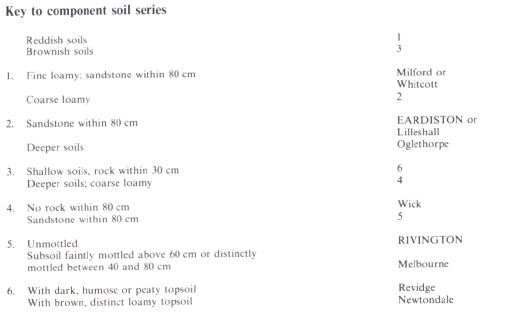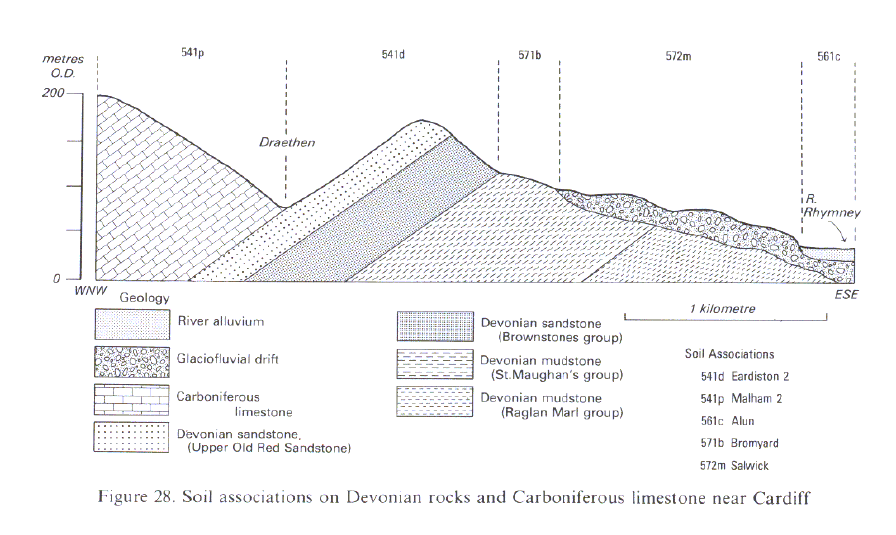
Soil Associations
0541d EARDISTON 2
Soil and site characteristics
Well drained often reddish coarse loamy soils over sandstone. Shallow in places. Steep slopes and bare rock locally.
Geology
Devonian and Permo-Triassic sandstone
Cropping and Land Use
Stock rearing on permanent grassland; coniferous and deciduous woodland.
Component soil series
| Subgroup | Series name | Percentage | WRB 2006 link |
|---|---|---|---|
| 5.41 | EARDISTON | 60% | Eutric Chromic Endoleptic Cambisols |
| 5.41 | RIVINGTON | 20% | Eutric Endoleptic Cambisols |
Covers 347 km2 in England and Wales
Soilscapes Classification
| 6 |
Freely draining slightly acid loamy soils |
0541d EARDISTON 2
Detailed Description
The association consists predominantly of coarse and fine loamy typical brown earths, in drift derived from Carboniferous and Jurassic shales interbedded with sandstones, on steep valley sides or escarpments. It occurs in Durham, Yorkshire, Cheshire and Derbyshire at heights ranging from 20 to 300 m O.D. Slopes vary greatly but are generally steeper than 4 degrees, with much land up to 25 degrees or more. The fine loamy East Keswick series, formerly Ambergate series, and the coarse loamy Wick series occur on slopes where the drift is more than 80 cm thick. The Neath series, fine loamy over sandstone, is found on convex upper or middle slopes. On the Carboniferous sandstone and shale of the Peak District, most of the steep and very steep slopes below 300 m O.D. are included in this association. These are mainly in the Derwent and tributary valleys from Little Eaton to the Derwent reservoir but there are smaller areas near Chesterfield, Ashover, Wirksworth and Kettleshulme. North of Matlock the soils are often below gritstone edges, the slopes being strewn with boulders. The association is very diverse and it is common to find soils of the Anglezarke, Rivington, Brickfield and Bardsey series. Well drained coarse loamy soils dominate this association which occupies 345 km² on reddish and brownish sandstones in south-east Wales, adjacent English counties and small parts of north Staffordshire. Most of the soils have solid or broken rock within 80 cm depth, but deeper soils occur, especially on concave lower slopes. Typical brown earths over sandstone occupy over half the land. They include Eardiston and Rivington series, the former is the more extensive and distinguished by its reddish colouring. Reddish fine loamy profiles of the Milford series are found locally. Shallow rankers of the Newtondale and Revidge series, and brown podzolic soils of the Whitcott series occur especially on higher ground, whilst on footslopes there are Oglethorpe and Wick soils. Melbourne series is found in a few small flushes and wetter hollows. The association is extensive on undulating land formed by the Brownstone group of the Lower Old Red Sandstone rocks in Gwent. It also forms a band around the eastern end of the south Wales coalfield from Cardiff almost to Brecon. North of Abergavenny and Crickhowell the rocks rise into the Black Mountains. Here the association often occupies steep valley sides and moderate slopes up to 500 m O.D. Brownish Rivington profiles rather than Eardiston series dominate the southern slopes of Sugar Loaf near Abergavenny. The summit of this hill has some ferric podzols. There is a larger proportion than usual of brown podzolic soils and rankers on the highest ground and the upper slopes of the deeply incised valleys also carry rankers and bare rock. There are minor inclusions of wet peaty-topped Wenallt soils in the heads of some of the tributary valleys which join the Grwyne Fechan from the north-east. The narrow valley floor of Cwm Coedcerrig, 6 km north of Abergavenny, includes about 10 ha of peat soils. Isolated calcareous profiles 3 km north of Crickhowell are related to springs from the limestones on Pen Cerrig-calch.
Soil Water Regime
East Keswick, Neath and Wick soils are well drained (Wetness Class I). Occasional seasonally waterlogged sites are associated with Bardsey and Heapey soils (Wetness Class III). The soils are absorbent and, despite the steep slopes, there is little winter run-off.
Cropping and Land Use
Because cultivation and cropping are restricted by gradient, the soils are mostly under poor grassland, scrub or deciduous and coniferous plantations. On ground sloping less than 11 degrees grassland can be managed more intensively and fields with favourable aspect and few boulders can be cultivated. There is little risk of poaching or rutting. The older hardwood plantations are dominated by beech and sycamore, though there is also some oak and ash. Exotic species are included in some of the large Derbyshire estates such as Chatsworth and Haddon. As much of the association is in the Peak District National Park, new plantings are required to be attractive. Many are of hardwoods with a conifer nurse crop such as Norway spruce which yields well on these soils. Scots pine, European larch, Western hemlock and Douglas fir are included for diversity and there is some Corsican pine on low ground. Windthrow is serious on exposed sites and harvesting is difficult on steep slopes. In Wales The soils are moderately acid and the land is used mostly for grazing sheep. The semi-natural vegetation is mainly bent-fescue grassland, though dry heather moor has developed on the higher parts of Mynydd Llangorse where the sward is undergrazed. Many of the steep valley sides are covered by dense bracken which reduces the value of the otherwise good grazing. Bilberry and bare rock on the steep upper slopes also provide poorer grazing. Gently sloping land below about 360 m O.D. is usually fenced and improved and so bears good permanent pasture. Winter rain is readily absorbed except on the steepest slopes, and there is little risk of poaching. The soils are slightly or moderately droughty depending mainly on their thickness. There is much forestry around Wentwood between Usk and Chepstow. A wide range of species is grown including deciduous trees. Trees generally grow well, Sitka spruce and Douglas fir being most productive. Forestry is also important in the Black Mountains. The soils do not limit tree growth except where shallow but steep slopes restrict the use of machinery in places. Recreation is an important secondary use of land in both Wentwood and the Black Mountains. The dry soils are convenient for nature trails and footpaths. Orienteering is currently a popular sport on the hills and there are large pony-trekking centres which use bridle-ways on the flanks of the mountains for most of the year. The Offa's Dyke long-distance path follows the north-eastern ridge of the mountains and crosses the association for some 6 km between Llanfihangel Crucorney and Hatterrall Hill.
0541d EARDISTON 2
Distribution Map
 |
Note that the yellow shading represents a buffer to highlight the location of very small areas of the association.
Keys to component soil series
Wales
 |
Typical Landscapes
Wales
 |
All information Copyright, Cranfield University © 2025
Citation: To use information from this web resource in your work, please cite this as follows:
Cranfield University 2025. The Soils Guide. Available: www.landis.org.uk. Cranfield University, UK. Last accessed 25/04/2025
